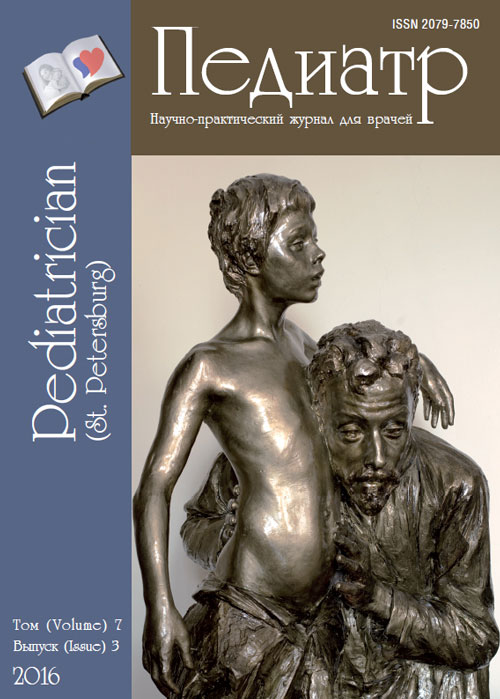Neuroimaging of full term newborn´s brain with hypoxic-ischemic encephalopathy
- 作者: Melashenko T.V1, Pozdnyakov A.V1, Alexandrov T.A1
-
隶属关系:
- St Petersburg State Pediatric Medical University
- 期: 卷 7, 编号 3 (2016)
- 页面: 157-161
- 栏目: Articles
- URL: https://journals.eco-vector.com/pediatr/article/view/5738
- DOI: https://doi.org/10.17816/PED73157-161
- ID: 5738
如何引用文章
详细
Introduction. Hypoxic-ischemic encephalopathy (HIE) in full term newborn is the most frequent courses of neonatal mortality and development of neurology handicap. Magnetic resonance imaging (MRI) is common noninvasive method for detect of post hypoxic brain lesions in newborn. Method of research. We assessed MR-pattern of hypoxic brain injury using Philips Ingenia 1.5 Tl for examination newborn on 14-16 days after delivery. Protocol of MRI scans included axial and coronal plan T1, T2, Flair weighted imaging (WI) and diffusion tensor imaging (DTI) with program Fiber tracking and detected fractional anisotropy (FA). FA was measuring within cortico-spinal tract besides. 3D reconstruction allowed to visualized white matter along the axon direction of cortico-spinal tract. Studies. Four full term newborn (after 37 weeks gestation) have been examined and separated in two groups. First group included newborns with HIE (evidence of fetal distress, low Apgar Scores, low umbilical cord pH ˂ 7.1, necessity for resuscitation and neurological signs, second group consisted term newborn without any medical and problems of health. Results of research. We detected MR-patterns of basal ganglia and thalamus lesions in newborn with HIE (abnormal high signal intensity on T1 and Flair WI). We didn’t detect any abnormal MR scans in healthy newborns (control group). FA within cortico-spinal tracts besides (total and ROI-1) were lower in newborns with HI then in healthy ones. Conclusion. This investigation showed common MR patterns of brain lesions in full term newborns with HIE which included changes of signal intensity T1 and Flair from basal ganglia and thalamus as well as reduction of FA within cortico-spinal tract.
关键词
全文:
作者简介
Tatiana Melashenko
St Petersburg State Pediatric Medical University
编辑信件的主要联系方式.
Email: melashenkotat@mail.ru
MD, PhD. Anesthesiology and Intensive Care Neonatal Perinatal Center 俄罗斯联邦
Alexander Pozdnyakov
St Petersburg State Pediatric Medical University
Email: pozdnyakovalex@ya.ru
MD, PhD, Dr Med Sci, Professor, Head. Department of Medical Biophysics, Radiology Department 俄罗斯联邦
Timofey Alexandrov
St Petersburg State Pediatric Medical University
Email: ale-tim@list.ru
Department of Medical Biophysics, Radiology Department 俄罗斯联邦
参考
- Мелашенко Т.В., Гузева В.В. Особенности транзиторной биоэлектрической активности головного мозга у недоношенных детей с перинатальным гипоксически-ишемическим поражением центральной нервной системы // Педиатр. — 2014. — Т. 5. — № 1. — С. 32–36. [Melashenko TV, Guzeva VV. Particular transit patterns EEG in premature babies with hypoxia-ischemic encephalopathy. Pediatr (St Petersburg). 2014;5(1):32-36. (In Russ).]
- Aeby A, Liu Y, Tiege X De, et al. Maturation of Thalamic Rediations between 34 and 41 Weeks Gestation: A Combined Voxel — Based Study and Probabilitic tractography with Diffusion Tensor Imaging. AJNR. 2009;30:1780-1786. doi: 10.3174/ajnr.A1660.
- Ball C, Boardman James P, Daniel Rueckert, et al. The Effect of Preterm Birth on Thalamic and Cortical Development. Cerebral Cortex. 2012;22(5):1016-1024. doi: 10.1093/cercor/bhr176.
- Barkovich AJ, Westmark K, Partridge C, et al. Perinatal asphyxia: MR findings in the first ten days. JNR. 1995;16:427-438.
- Cabaj AG, Bekiesin’ska-Figatowska M., Madzic J. MRI patterns of hypoxic — ischemic brain injury in preterm and full term infants — classical and less common MR findings. Pol J Radiol. 2012;77(3):71-76. doi: 10.12659/PJR.883379.
- Cowan F, Rutherford M, Groenendaal F, et al. Origin and timing of brain lesions in term infants with neonatal encephalopathy. Lancet. 2003;361:736-742. doi: 10.1016/S0140-6736(03)12658-X.
- Dergans M, Osredkar D. Hypoxic-ischemic brain injury in the neonatal period — current concepts, novel diagnostic approaches and neuroprotective strategies. Zdrav Vestn. 2008;77(II):51-8.
- Himmelmann K, Hagberg G, Wiklund LM, et al. Dyskinetic cerebral palsy: a population-based study of children born between 1991 and 1998. Dev Med Child Neurol. 2007;49:246-251. doi: 10.1111/j.1469-8749.2007.00246.x.
- Kurinczuk JJ, White-Koning M, Badawi N. Epidemiology of neonatal encephalopathy and hypoxic-ischaemic encephalopathy. Early Hum Dev. 2010;86:329-338. doi: 10.1016/j.earlhumdev.2010.05.010.
- Linda S. de Vries, Groenendaal F. Patterns of neonatal hypoxic-ischaemic brain injury. Neuroradiology. 2010;52:555-566.
- Linda S de Vrries, Jongmans MJ. Long-term outcome after neonatal hypoxic — ischaemic encephalopathy. Arch Dis Child Fetal Neonatal Ed. 2010;95: F220-F224. doi: 10.1007/s00234-010-0674-9.
- Nikas I, Dermentzoglou V, Theotanopoulou M, Theodoropoulos V. Parasagittal Lesions and Ulegyria in Hypoxic-Ischemic Encephalopathy: Neuroimaging Findings and Review of the Pathogenesis. Child Neurol. 2008;23(1):51-58. doi: 10.1177/0883073807308694.
- Nucitora PGP, Verma R, Lee S-K, Methem ER. Diffusion — Tensor MR Imaging and Tractography: Exploring Brain Microstructure and Connectivity. Radiology. 2007;245:367-384. doi: 10.1148/radiol.2452060445.
- Rosenbloom L. Dyskinetic cerebral palsy and birth asphyxia. Dev Med Child Neurol. 1994;36(4):285-289. doi: 10.1111/j.1469-8749.1994.tb11848.x.
- Sarnat HB, Sarnat MS. Neonatal encephalopathy following fetal distress: a clinical and electroencephalographic study. Archives of Neurology. 1976;33:696-705. doi: 10.1001/archneur.1976.
- Ten Vadim S, Tang Haijing, Bradley-Moore M, et al. Late Measures of Brain Injury After Neonatal Hypoxia-Ischemia in Mice. Stroke. 2004;35:2183-2188. doi: 10.1161/01.STR.0000137768.25203.df.
- Twomey E, Twomey A, Ryan S, et al. MR imaging of term infants with hypoxic — ischaemic encephalopathy as a predictor of neurodevelopmental outcome and late MRI appearance. Pediatr Radiol. 2010;40:1526-1535. doi: 10.1007/s00247-010-1692-9.
- Volpe JJ. Brain injury in premature infants: a complex amalgam of destructive and developmental disturbances. Lancet Neurol. 2009;8:110-124. doi: 10.1016/S1474-4422(08)70294-1.
- Yeatman JD, MB-Shachar, Bammer R, Feldman HM. Using Diffusion Tensor Imaging and Fiber Tracing to Characterize Diffuse perinatal White Matter Injury: A case Report. J of Child Neurology. 2009;24:794-800. doi: 10.1177/0883073808331080.
补充文件






